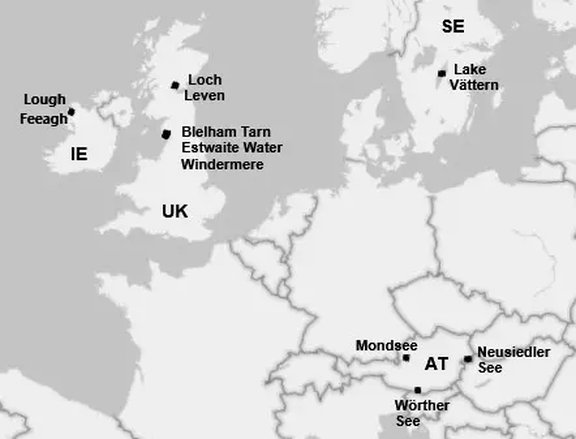The annual maximum surface temperature effects the structure and function of the lake ecosystem. More than the physiological functions of organisms and the biogeography also the survival of species will be influenced. When the maximum temperature of a lake exceeds over a longer period the temperature will also increase in deeper water levels and lowers the temperature tolerance of aquatic organisms. Highly sensitive organisms e.g. some algae, fish or plankton organisms, have to move to deeper areas of the lake. Light and oxygen conditions they come across may not be ideal or are a limiting factor for them. This may interfere with their growth and reproduction rate or downgrade the living conditions of sensitive species massively and they become extinct in this area.
An international team under the lead of the Mondsee researcher Martin T. Dokulil published the surface temperatures of ten lakes in Ireland, Great Britain, Sweden and Austria in the journal Climatic Change recently. The data have been collected between 1966 und 2015 to quantify changes of the annual maximum temperature and the duration of the potential critical temperature above 20°C. The results are alarming: The annual maximum lake surface temperature has increased at an average rate of +0,58°C per decade. This is similar to the observed increase in annual maximum air temperature of +0,42°C per decade over the same period. The average increase in maximum temperature over time, + 0,58°C is greater than the global average increase of +0,34°C per decade, +0,42°C for 22 lakes in Austria and + 0,39°C for nine lowland lakes in Poland. During the investigation the periods with surface temperatures more than 20°C increased significantly and the warming reached the critical level more often during the year and lasted longer.

The Epilimnion is the top warmed-up and highly turbulent layer in a layered lake. The cool layer close to the ground is called Hypolimnion. These two zones are buffered by the Metalimnion, an interjacent thermocline. In this layer the drop of temperature can reach up to 10°C. The data analysis from the Austrian lake Mondsee show a clear increase of those days when the water temperature was more than 20°C. Within the 50 years of investigation also the critical temperature increased continuously from less than 1m to 6m depth. This increasingly warming is especially alarming in lake Mondsee with its 68m maximum depth and cool Hypolimnion. To reach these high temperature lake Mondsee underwent several consecutive years with heat waves. Shallow lakes like lake Neusiedlersee in Burgenland, a Pannonian endorheic lake, experienced water temperatures more than 20°C in several years during the research period even 31,7°C. The influence on the aquatic ecosystem especially the metabolism at all levels of the food web, on growth rates, biodiversity and the invasion of species also depends on the geographic location (e.g. mild, balanced climate resulting from the Gulf Stream). Extended periods of maximum surface temperature will also alter lake trophic status. The increase of nutrients in the lake followed by algal blooms can impact the organisms and organism assemblages, from bacteria to fish, negatively. The survival of the species is directly depending on the exposure of species to a high maximum temperature, their flexibility and their resilience to new conditions. The alternative solution, namely to move to deeper and cooler lake areas is not possible for all organisms or may fail in the future because of the lack of deep zones with high oxygen content in our lakes.
Original publication: Dokulil M.T., de Eyto E., Maberly S.C. et al. (2021). Increasing maximum lake surface temperature under climate change. Climatic Change 165, 56 (2021). https://doi.org/10.1007/s10584-021-03085-1
Open access funding provided by University of Innsbruck and Medical University of Innsbruck.
(Sabine Wanzenböck)

